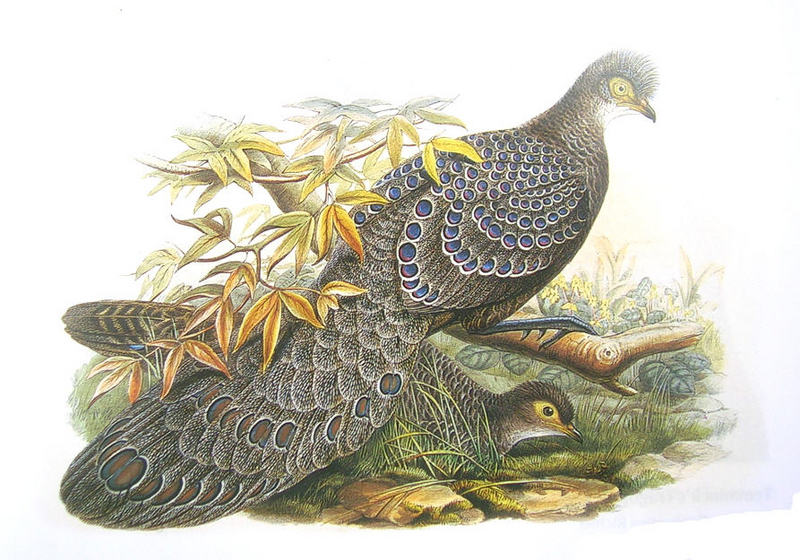|
| Query: germain's peacock-pheasant | Result: 8th of 10 | |
Grey Peacock-pheasant (Polyplectron bicalcaratum) - Wiki
| Subject: | Grey Peacock-pheasant (Polyplectron bicalcaratum) - Wiki
| |

| Resolution: 893x625
File Size: 137081 Bytes
Upload Date: 2007:09:28 17:14:07
|
Grey Peacock-pheasant
From Wikipedia, the free encyclopedia
[Photo] Grey Peacock-pheasant (Polyplectron bicalcaratum). Source: A Century of Birds from the Himalayas (1830-32). Date 1832. Author John Gould. License: public domain
The Grey Peacock-pheasant, Polyplectron bicalcaratum also known as Burmese Peacock or Chinquis Peacock-pheasant is a large, up to 76cm long, greyish brown pheasant with finely spotted green ocelli, elongated bushy crest, bare pink or yellow facial skin, white throat, and grey iris, bill and legs. Both sexes are similar. The female is smaller and darker than male. The young resembles the female.
The Grey Peacock-pheasant is distributed to lowland and hill forests of mainland southeast Asia, but excluding most of Indochina. The female usually lays two eggs. The diet consists mainly of seeds, termites, fruits and invertebrates.
The phylogeny of this species is fairly enigmatic. mtDNA cytochrome b and D-loop as well as the nuclear ovomucoid intron G data confirms that it belongs to a clade together with Germain's Peacock-pheasant, but also the "brown" southernly species Bronze-tailed Peacock-pheasant and Mountain Peacock-pheasant (Kimball et al. 2001).
The molecular data suggests that its closest relative - though not with high confidence - is the Bronze-tailed Peacock-pheasant. This is unlikely to be strictly correct for two reasons. First, biogeography is equivocal towards the timing of divergence of the "brown" species, tentatively suggesting the Mountain Peacock-pheasant may be a more recent divergence from mainland stock.
Second, the molecular data itself is spurious in this species, the most morphologically diverse and widespread Polyplectron: There is no data on the origin and number of specimens, but it is fairly likely that only a single bird, possibly of captive origin and undeterminable subspecific allocation, was sampled. All that can be reasonably assumed is that the Grey Peacock-pheasant evolved on mainland Southeast Asia, probably during the Late Pliocene to Early Pleistocene (3.6-1 mya).
Lowe's Grey Peacock-pheasant, P. b. bailyi, was described from a captive bird of unknown provenance (Lowe 1924). Similar examples have turned up on occasion, but the validity and - if distinct - home range of this taxon remains unknown. It was theorized to inhabit western Assam or the eastern Himalayas, but this is based on conjecture.
The Grey Peacock-pheasant is the national bird of Myanmar.
Widespread throughout its large range, the Grey Peacock-pheasant is evaluated as Least Concern on the IUCN Red List of Threatened Species. It is listed on Appendix II of CITES
http://en.wikipedia.org/wiki/Grey_Peacock-pheasant
| The text in this page is based on the copyrighted Wikipedia article shown in above URL. It is used under the GNU Free Documentation License. You may redistribute it, verbatim or modified, providing that you comply with the terms of the GFDL. |
|
 |

|

|
germain's peacock-pheasant
8/10 |

|
 |
^o^
Animal Pictures Archive for smart phones
^o^
|
|